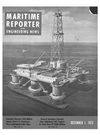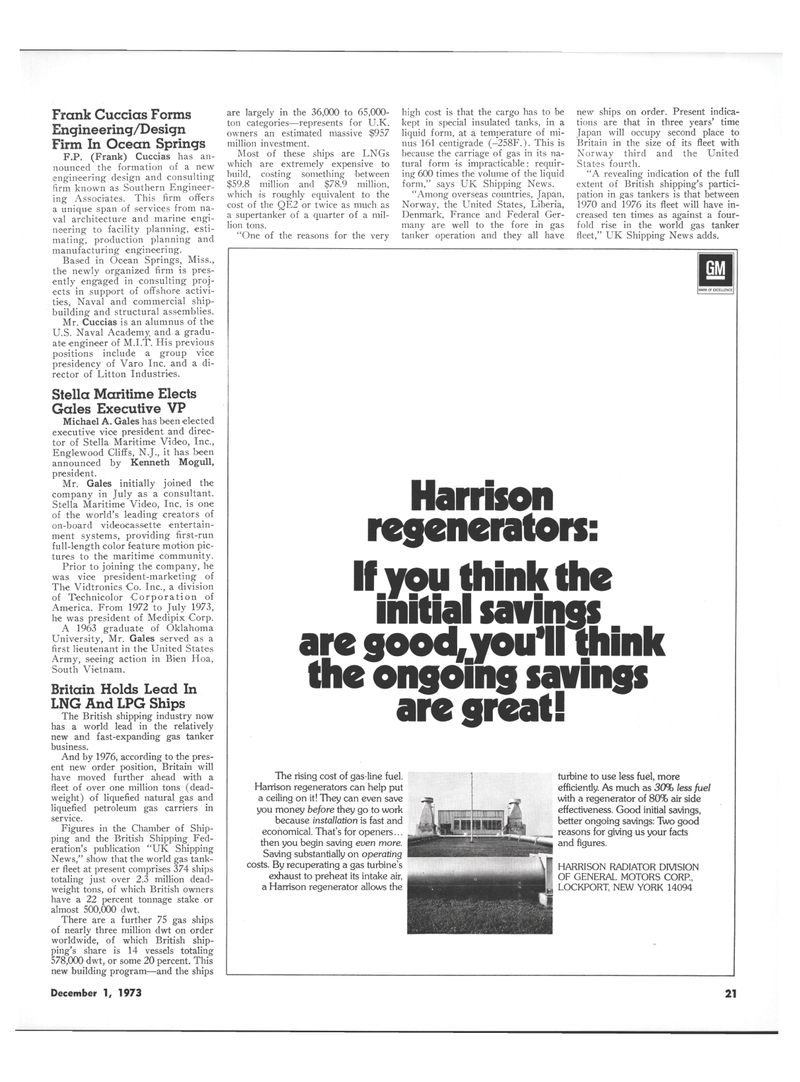
Page 17: of Maritime Reporter Magazine (December 1973)
Read this page in Pdf, Flash or Html5 edition of December 1973 Maritime Reporter Magazine
Frank Cuccias Forms
Engineering/Design
Firm In Ocean Springs
F.P. (Frank) Cuccias has an- nounced the formation of a new •engineering design and consulting firm known as Southern Engineer- ing Associates. This firm offers a unique span of services from na- val architecture and marine engi- neering to facility planning, esti- mating, production planning and manufacturing engineering.
Based in Ocean Springs, Miss., the newly organized firm is pres- ently engaged in consulting proj- ects in support of offshore activi- ties, Naval and commercial ship- building and structural assemblies.
Mr. Cuccias is an alumnus of the
U.S. Naval Academy and a gradu- ate engineer of M.I.T. His previous positions include a group vice presidency of Varo Inc. and a di- rector of Litton Industries.
Stella Maritime Elects
Gales Executive VP
Michael A. Gales has been elected executive vice president and direc- tor of Stella Maritime Video, Inc.,
Englewood Cliffs, N.J., it has been announced by Kenneth Mogull, president.
Mr. Gales initially joined the company in July as a consultant.
Stella Maritime Video, Inc. is one of the world's leading creators of on-board videocassette entertain- ment systems, providing first-run full-length color feature motion pic- tures to the maritime community.
Prior to joining the company, he was vice president-marketing of
The Vidtronics Co. Inc., a division of Technicolor Corporation of
America. From 1972 to July 1973, he was president of Medipix Corp.
A 1963 graduate of Oklahoma
University, Mr. Gales served as a first lieutenant in the United States
Army, seeing action in Bien Hoa,
South Vietnam.
Britain Holds Lead In
LNG And LPG Ships
The British shipping industry now has a world lead in the relatively new and fast-expanding gas tanker business.
And by 1976, according to the pres- ent new order position, Britain will have moved further ahead with a fleet of over one million tons (dead- weight) of liquefied natural gas and liquefied petroleum gas carriers in service.
Figures in the Chamber of Ship- ping and the British Shipping Fed- eration's publication "UK Shipping
News," show that the world gas tank- er fleet at present comprises 374 ships totaling just over 2.3 million dead- weight tons, of which British owners have a 22 percent tonnage stake or almost 500,000 dwt.
There are a further 75 gas ships of nearly three million dwt on order worldwide, of which British ship- ping's share is 14 vessels totaling 578,000 dwt, or some 20 percent. This new building program—and the ships are largely in the 36,000 to 65,000- ton categories—represents for U.K. owners an estimated massive $957 million investment.
Most of these ships are LNGs which are extremely expensive to build, costing something between $59.8 million and $78.9 million, which is roughly equivalent to the cost of the QE2 or twice as much as a supertanker of a quarter of a mil- lion tons. "One of the reasons for the very high cost is that the cargo has to be kept in special insulated tanks, in a liquid form, at a temperature of mi- nus 161 centigrade (-258F.). This is because the carriage of gas in its na- tural form is impracticable: requir- ing 600 times the volume of the liquid form," says UK Shipping News. "Among overseas countries, Japan,
Norway, the United States, Liberia,
Denmark, France and Federal Ger- many are well to the fore in gas tanker operation and they all have new ships on order. Present indica- tions are that in three years' time
Japan will occupy second place to
Britain in the size of its fleet with
Norway third and the United
States fourth. "A revealing indication of the full extent of British shipping's partici- pation in gas tankers is that between 1970 and 1976 its fleet will have in- creased ten times as against a four- fold rise in the world gas tanker fleet," UK Shipping News adds.
MARK OF EXCELLENCE
Harrison regenerators:
If you think the initial savings are good, you'll think the ongoing savings are greatl
The rising cost of gas-line fuel.
Harrison regenerators can help put a ceiling on it! They can even save you money before they go to work because installation is fast and economical. That's for openers... then you begin saving even more.
Saving substantially on operating costs. By recuperating a gas turbine's exhaust to preheat its intake air, a Harrison regenerator allows the turbine to use less fuel, more efficiently. As much as 30% less fuel with a regenerator of 80% air side effectiveness. Good initial savings, better ongoing savings: Two good reasons for giving us your facts and figures.
HARRISON RADIATOR DIVISION
OF GENERAL MOTORS CORP.,
LOCKPORT, NEW YORK 14094
December 1, 1973 21

 16
16

 18
18
